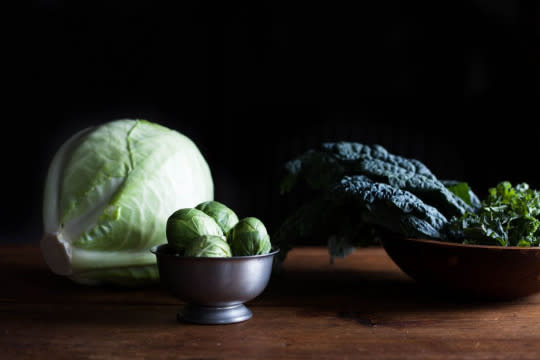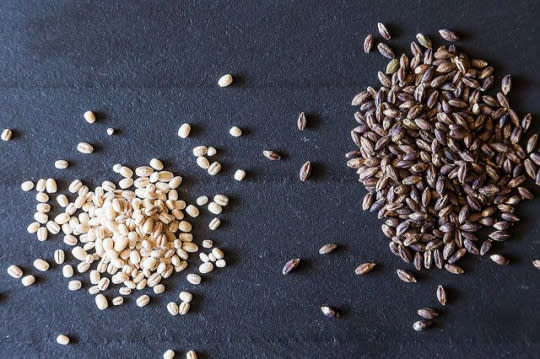How to Make the Salads of Your Dreams — Without Going Broke
Bye, bye, ‘nog. Until next year, holidays roasts. Donuts, oh donuts—parting is such sweet sorrow. The age of international cookies, ragu-topped carbohydrates, and fudge has gone.
Related: 13 Lunch-Ready Salads for Every Food Mood
The age of the salad has come.

Meet salad, your new best friend. (Photo: James Ramson/Food52)
Wait, hold the phone—salads are good, too! At least the ones that consist of more than some wilted leaves, sad pre-shaved carrots, and a slick of oil-and-vinegar.
Related: Dinner Tonight: Roasted Chickpea Salad with Za'atar
There’s only one problem: Truly great, craveable salads that keep you full for more than an hour or two can be very expensive to make. In the words of my salad-loving editor, Sarah Jampel: “Once you buy the leaves (expensive) and all the add-ons (also expensive), you’ll easily have spent more money than you would’ve had you just picked up a salad at the Sweetgreen that, let’s say hypothetically, is two blocks away from your apartment (yes). And none of the ingredients keep for long, so what’s a person to do?”
Related: Sqirl’s Genius Crispy Rice Salad is Rice Living Its Best Life
I might not have a Sweetgreen two blocks from my apartment—or anywhere in this town I call home—but I do understand the true struggle of any salad-lover who is also on a budget.
Here are a few tricks to save some green, while still eating your… you know.

An addictive, tahini-soaked spin on roasted broccoli. (Photo: Bobbi Lin/Food52)
Related:
1) Buy in season. Yes, in a perfect world, we would all be slicing sexy beefsteak tomatoes on top of asparagus on top of roasted acorn squash. Unfortunately, unless you live in California, most of us have to deal with seasons. So let’s embrace the inevitable. Not only is it better for the planet to purchase in-season produce, it’s also better for your wallet. Selfish, meet selfless.
2) Buy only what you need. This might seem like an impractical notion in today’s Costco-loving society (and believe me, I love Costco), but it makes sense. Buying large amounts of meat or produce often means you end up throwing some away. If you buy only what you need, you can eliminate both food and money waste. Plus you can orbit your dinner plans around what’s on sale. Two for one chickpeas? Done deal.
Related: A Salad That’s Sweet, Sour & Smoky at the Same Time
3) Skip the pre-packaged spring mix. Not only do those mixes cost more, they’re also apt to go smooshy and smelly very quickly. Stick to whole heads of lettuce or bunches of other greens. If you’re really craving spring mix, go to a grocery store that has bulk lettuces and fill up a bag with exactly how much you’ll need for your meal. Or, even better, head to the farmer’s market! If it’s open, of course.

Don’t be afraid to try new greens! (Photo: Eric Moran/Food52)
4) Select heartier, free-form greens for your base. Not only are they often cheaper than their more delicate lettuce brethren, they also last longer. Kale is always a popular choice, both lacinato and curly, but you should explore the entire brassica family. Cabbage, brussels sprouts, and collard greens are a great backbone for your salad—why not try a few together? Broccoli and cauliflower shred up beautifully, too, and last for days once dressed.
5) Make dressings in bulk. When you have a zingy dressing already mixed up in your fridge, you are precisely seven times more likely to make salad for dinner than ordering takeout. It’s scientifically proven.
If you’re worried about the effect that aged balsamic and mountains of fresh herbs will have on your budget, don’t fear—there are all sorts of thrifty dressings out there: There are ones that use up leftover pesto, or bits of stale bread, or the dregs of your red wine; ones that grab your attention with little more than a lemon and some capers; ones that can make any salad feel brighter.

We’re in love with this lemon caper dressing. (Photo: James Ransom/Food52)
For the simplest, still-effective dressing, however, all you really need is a jar of mustard, some olive oil, and a bit of apple cider vinegar. Shake in a mason jar until creamy.
6) Add cheap proteins. It’s awfully challenging for salads to keep you full without a dose of protein. Beans, boiled eggs, lentils, rotisserie chicken, and canned fish are all inexpensive ways to pack a wallop of protein onto your greens. Play around with the proportions: Make your salad more protein, less green when you’re really hungry, and vice versa when you want a lighter option.

Add some grains to your salad. (Photo: James Ransom/Food52)
7) Grains are good. I sometimes feel a pang of guilt when my salads end up looking more grain than green. But why shouldn’t they? Whole grains, like quinoa or barley, are full of nutrients, dietary fiber, and other things that are good for you. They make your salad a whole lot heartier. Plus they’re relatively cheap to buy in bulk, as long as you steer clear of anything too trendy.
8) Use leftovers in your salads. Most leftovers can be revitalized with the addition of a tangy dressing, some greens, and a scoop of cooked grains. Plus, leftover salads are exciting because you never make the same thing twice—and you never know exactly what to expect. Who knows, maybe last night’s salmon will taste awesome with some collard greens and a little tahini dressing! There’s only one way to find out.
By Catherine Lamb.
